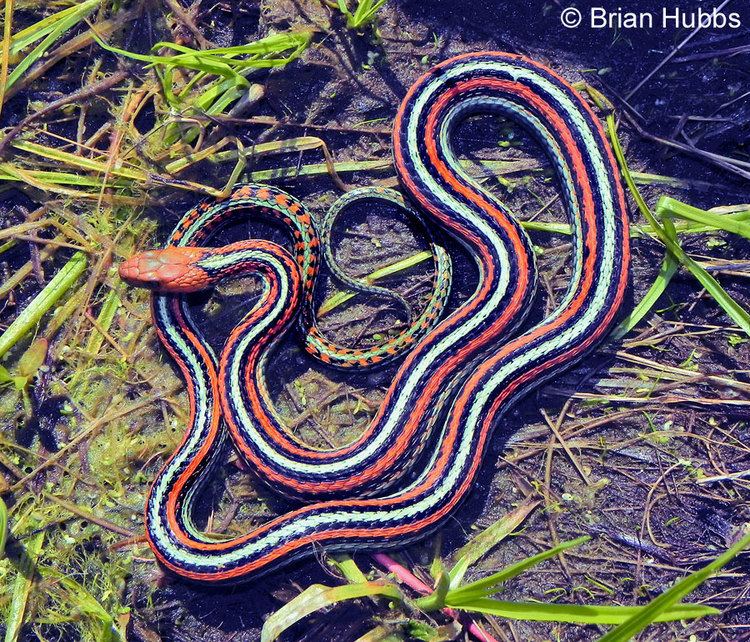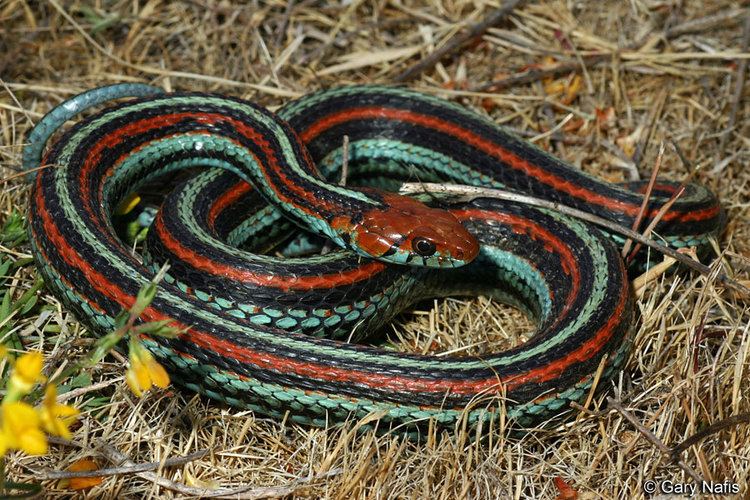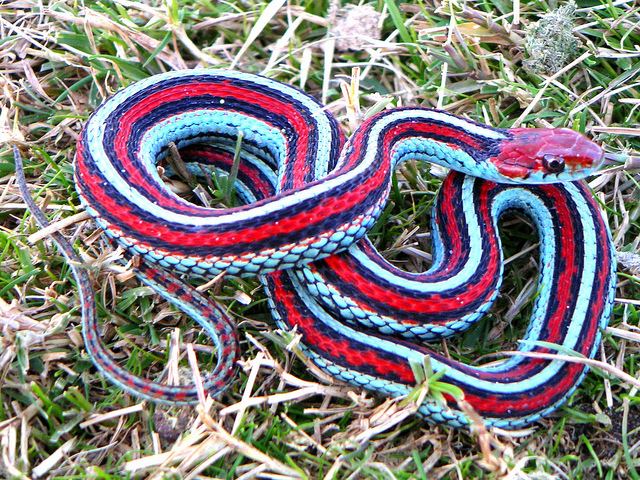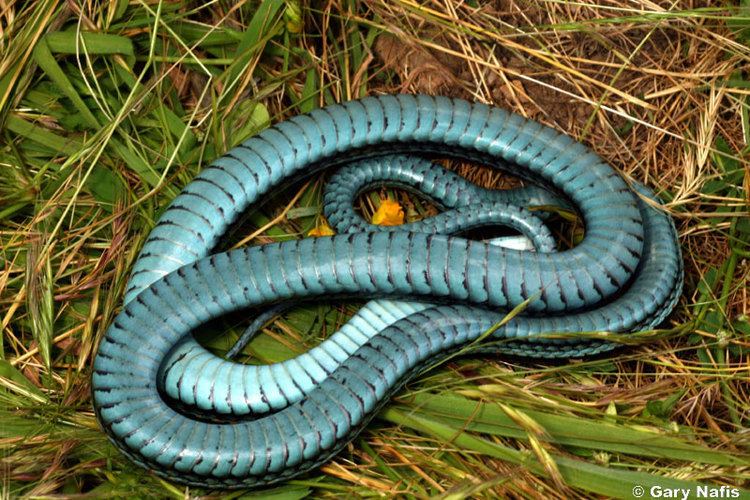Subphylum Vertebrata Suborder Serpentes Higher classification Common garter snake | Phylum Chordata Rank Subspecies | |
 | ||
Scientific name Thamnophis sirtalis tetrataenia Similar Garter snake, Snake, Common garter snake, Reptile, Checkered garter snake | ||
Brian gundy finds san francisco garter snake one of the most rare beautiful snakes on the planet
The San Francisco garter snake (Thamnophis sirtalis tetrataenia) is a slender multi-colored subspecies of the common garter snake. Designated as an endangered subspecies since the year 1967, it is endemic to San Mateo County and the extreme northern part of coastal Santa Cruz County in California. Some researchers estimate that there are only 1,000 to 2,000 adult snakes of the subspecies T. s. tetrataenia remaining. However, the full extent of the snakes' habitat has not been fully documented, and many snakes may utilize creeks and other waterways that are currently unexplored. This garter snake prefers wet and marshy areas, and because of its elusive nature, it is difficult to see or capture.
Contents
- Brian gundy finds san francisco garter snake one of the most rare beautiful snakes on the planet
- Brian gundy finds second san francisco garter snake of 2016
- Geographic range
- Habitat
- Diet
- Taxonomy and relation to other garter snakes
- DNA analysis
- Outlook for this subspecies
- References

Brian gundy finds second san francisco garter snake of 2016
Geographic range
The San Francisco garter snake, a subspecies of the common garter snake, is found in scattered wetland areas on the San Francisco Peninsula from approximately the northern boundary of San Mateo County south along the eastern and western bases of the Santa Cruz Mountains, at least to the Upper Crystal Springs Reservoir, and along the Pacific coast south to Año Nuevo Point, and thence to Waddell Creek in Santa Cruz County. It is difficult to obtain reliable distribution information and population statistics for the San Francisco garter snake, because of the elusive nature of this reptile and the fact that much of the remaining suitable habitat is located on private property that has not been surveyed for the presence of the snake. This subspecies is extremely shy, difficult to locate and capture, and quick to flee to water or cover when disturbed. The U.S. Fish and Wildlife Service has stated that many locations that previously had healthy populations of garter snakes are now in decline due to land development pressure and the filling of wetlands in San Mateo County over the last sixty years. However, in many areas where it still occurs, it is not rare, but is actually quite common and can be viewed with good success once its behavior is understood.
Habitat

The preferred habitat of the San Francisco garter snake is a densely vegetated pond near an open hillside where it can sun, feed, and find cover in rodent burrows; however, markedly less suitable habitat can be successfully used. Temporary ponds and other seasonal freshwater bodies are also appropriate. This subspecies avoids brackish marsh areas because its preferred prey, the California red-legged frog (Rana draytonii), cannot survive in saline water. Emergent and bankside vegetation such as cattails (Typha spp.), bulrushes (Scirpus / Schoenoplectus spp.), and spike rushes (Juncus spp. and Eleocharis spp.) apparently are preferred and used for cover. The zone between stream and pond habitats and grasslands or bank sides is characteristically utilized for basking, while nearby dense vegetation or water often provide escape cover. The subspecies occasionally uses floating algal or rush mats, when available.
Diet

San Francisco garter snakes forage extensively in aquatic habitats. Adult snakes feed primarily on California red-legged frogs (Rana draytonii), which are federally listed as threatened. They may also feed on juvenile bullfrogs (Rana catesbeiana), but they are unable to consume adults; in fact, adult bullfrogs prey on juvenile garter snakes, and may be a contributing factor in the population decline of the San Francisco garter snake. Newborn and juvenile San Francisco garter snakes depend heavily upon Pacific treefrogs (Pseudacris regilla ) as prey. If newly metamorphosed Pacific treefrogs are not available, the young garter snakes may not survive. San Francisco garter snakes are one of the few animals capable of ingesting the toxic California newt (Taricha torosa) without incurring sickness or death.
Taxonomy and relation to other garter snakes
For a brief period from 1996 to 2000 there was confusion over the differentiation of the San Francisco garter snake from two other subspecies, known as the California red-sided garter snake (T. s. infernalis) and the Oregon red-spotted garter snake (T. s. concinnus). Barry petitioned the International Commission on Zoological Nomenclature (ICZN) to suppress the changes proposed in 1996 to merge two of these species. In 2000, the ICZN agreed and voted to retain the historical taxonomic arrangement of subspecies within this evolutionary lineage. Accordingly, the subspecies tetrataenia was reaffirmed for the San Francisco garter snake and the races concinnus and infernalis retain their historical definition.
The San Francisco garter snake cohabits ecosystems that host two other species of garter snake: the coast garter snake (Thamnophis elegans terrestris), a subspecies of Western Terrestrial Garter Snake (T. elegans), and the Santa Cruz aquatic garter snake (Thamnophis atratus atratus) a subspecies of the aquatic garter snake (T. atratus). These three subspecies are known to prey upon same foods; however, their preferences are slightly different. Herpetologist Sean Barry notes that they divide up the food resource as follows:
DNA analysis
While the findings of the ICZN have given the San Francisco garter snake unique taxonomic standing for now, a molecular study challenges the subspecific status of this population. Janzen analyzed sequences in mitochondrial DNA to determine relationships within the common garter snake (T. sirtalis). Janzen found that molecular evidence differed, often sharply, with the territorial boundaries of subspecies named on phenotypic variation. He further deduced that local environmental forces were more significant in shaping the color patterns shown by the garter snakes than shared common ancestry, and concluded all morphologically based subspecies in the western U.S. to be subject to revision. This result strongly suggests that the color traits that are diagnostic for (T.s. tetrataenia) are the result of local selection rather than long-term isolation from other races of (T. sirtalis) in central California. On the other hand, the article places the three nearest populations of T. s. infernalis to T.s. tetrataenia in Sonoma County, Contra Costa County, and Santa Clara County into a separate group that exhibits an "elevated rate of molecular evolution". The authors suggest that sequencing nuclear DNA may provide a more precise analytical tool to crack some of the ultimate taxonomic quandaries of the San Francisco garter snake and its relatives.
Outlook for this subspecies
Many of the factors that led to the listing of the San Francisco garter snake in 1967 continue to affect the organism. These environmental elements include loss of habitat from agricultural, commercial and urban development as well as collection by reptile fanciers and breeders. Collection of these endangered animals by private citizens remains illegal.
